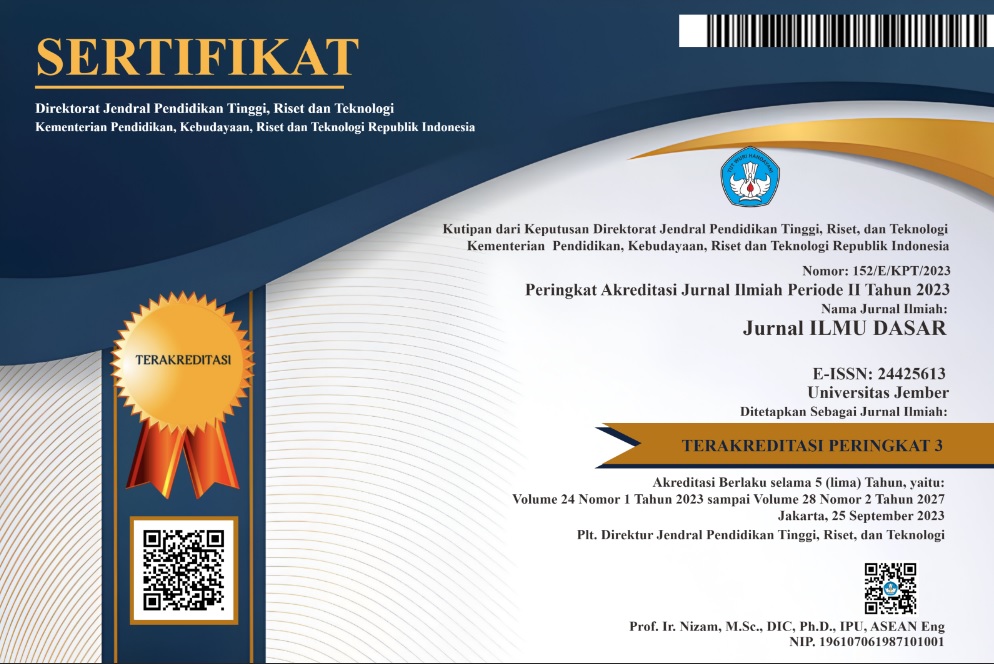Synthesis of Nanosilica from Padas Stone to Reduce The Total Organic Carbon of Palm Oil Waste
DOI:
https://doi.org/10.19184/jid.v20i1.8679Keywords:
synthesis, nanosilica, padas stone, total organic carbon, oil wasteAbstract
Padas stone is one of the natural mineral containing 67.5% of SiO2 compounds. In this research, synthesis of nanosilica was carried out by sol-gel method asistanced by 2.45 GHz microwave radiations with low (10%), medium (50%) and high (100%) power at 30 and 60 minutes of contact times. It was analyzed by XRD, BET, FTIR spectrophotometry and SEM. The synthesized silica was then used as absorbent for total organic carbon (TOC) of palm oil waste. The results show that the synthesized silica was a mixture of cristobalite and quartz type minerals according to ICDD No. 00-003-0271 and 01-083-287. The surface area and silicon dioxide contains are 12.174 m2/g and 76.325% for silica without microwave assistance (SiO2-TPMW); 12.796 m2/gand 86.385% for silica with 30 minutes on 10% microwave assistance(SiO2 -MW 10A); 12.735 m2/gand 86.254% for silica with 60 minutes on 10% microwave assistance (MW 10B); 13,659 m2/gand 87.211% for MW 50A; 13,583 m2/g and 86.684% for MW 50B;7.883 m2/gand 57.527% for MW 100A; also 8.752 m2/g and 37.725% for MW 100B, respectively. The use of silica as an absorbent of TOC shows the effectiveness of 62.89% (TPMW); 63.68% (MW 10A); 62.96% (MW 10B); 65.25% (MW 50A); 64.61% (MW 50B); 62.37% (MW 100A) and 61.18% (MW 100B) from the initial TOC of 1520 mg/L.
Keywords: synthesis, nanosilica, padas stone, total organic carbon, oil waste.
Downloads
References
Gaba, M& Neelima, D. 2011. Microwave Chemistry : General Features and Aplications. Indian Journal of Pharmaceutical Education Researchs, 45(2):175-183.
Han, R, Zou, W, Zhang, Z, Shi, J& Yang, J. 2006. Removal of Copper(II) and Lead(II) From Aqueous Solution by Manganes Oxide Coated Sand : Characterization and Kinetic Study. Journal of Hazardous Materials, 137B:384-395.
Komarneni. 2002. Microwave-Polyol Process for Pt and Ag Nanoparticles. Langmuir, 18(15): 5959-5962.
Kushwaha, AK, Gupta, N Chattopadhyaya, MC. 2010.Enhanced Adsorption of Malachite Green Dye on Chemically Modified Silica Gel.Journal of Chemical Pharmacy Research, 2(6):34-45.
Le, VH, Thuc, CNH & Thuc, HH. 2013. Synthesis of Silica Nanoparticles From Vietnamese Rice Husk by Sol-Gel Method. Nanoscale Research Letters, 8(1): 58-68.
Lee, JC, Chen, CH, Cheng, S& Li HY. 2016. Adsorption of Pb(II) and Cu(II) Metal Ions on Functionalized Large-Pore Mesoporous Silica. International Journal of Environment Science Technology, 13 : 65-76.
Liew, YM, Kamarudin, H, Bakri, AMMA, Luqman, M, Nizar, IK&Heah, CY. 2011. Investigating the Possibility of Utilization of Kaolin and the Potential of Metakaolin to Produce Green Cement for Construction Purpose-A Review. Australian Journal of Basic and Applied Sciences, 5(9):441-449.
Lovingood, DD, Owens JR, Seeber M, Kornev KG & Luzinov I. 2013. Preparation od Silica Nanoparticles Through Microwave-Assisted Acid-Catalysis. Journal of Visualized Experiments, 82-88.
Matias, T, Marques, J, Quina, MJ, Ferreira, LG &Vallante, AJM. 2015. Silica Based Aerogels as Adsorbents For Phenol-Derivative Compound. Colloid and Surface A : Physicochemical Engineering Aspects, 480:260-269.
Mouhrly, A, Khacani, M, El-Hamidi, A, Kacimi, M, Halim, M & Arsalane, S. 2015. The Synthesis And Characterization of Low-Cost Mesoporous Silica SiO2 From Local Pumice Rock. Nanomaterials & Nanotechnology, 5(35) : 1-7.
Prawiyanto, Y, Shofiyani, A & Zaharah, TA.2018. Synthesis And Characterizatuon of Zeolite Materials From Power Plant Fly Ash.Asian Journal of Chemistry, 30(5) : 993-997.
Punuri, JB, Sharma, P, Sibyala, S, Tamuli, S & Bora, U. 2012. Piper Betle-Mediated Green Synthesis of Biocompatible Gold Nanoparticles,.International Nano Letters, 2(18):1-9.
Rahman, IA &Padavettan, V. 2012, Synthesis of Silica Nanoparticles by Sol Gel : Size-Dependent Properties, Surface Modification and Application in Silica Polymer Nanocomposites:A Review. Journal of Nanomaterials, 1-15.
Reis, EF, Campos, FS, Lage, AP & Leite, LC. 2006.Synthesis and Characterization of Poly (Vinyl Alcohol) Hydrogels and Hybrids ForMPB70 Protein Adsorption. Material Research, 9(2):185-191.
Singh, ACH. 2017. Preparation of Amino-Functionalized Silica Gel Adsorbents For Adsorption of Heavy Matal Ions. International Journal of Advance in Science, Engineering and Technology, 5(3):63-67.
Srivastava, K, Shringi N, Devra, V& Rani, A. 2015. A Facile Method ForProduction of Amorphous Silica FromPerlite Under Microwave Irradiation.International Journal of IT, Engineering and Applied Sciences Research, 4:18–24.
Sukirno, E, Shofiyani, A & Nurlina. 2017. Pembuatan Membran Komposit Si/PVA/PEG Berbahan Dasar Silika Batu Padas Singkup untuk Menurunkan Kosentrasi Ion Fosfat dalam Larutan.Jurnal Kimia Khatulistiwa,6(4):1-9.
Susetyaningsih, R, Kismolo, E& Basuki, KT. 2008.Pengaruh Penambahan MgO pada Peningkatan Kualitas Lempung Kasongan untuk Imobilisasi Lumpur Limbah Pb Menggunakan Teknologi Keramik..Seminar Nasional IV, SDM Teknologi Nuklir, Yoyakarta, 307-315.
Tompsett, GA, William, CB&Sigfrid, K. 2006. Microwave Synthesis of Nanoporous Materials. Chem Phys Chem, 7:296-319.
Trivana, L, Sugiarti S & Rohaeti E. 2015.Sintesis dan Karakterisasi Natrium Silikat (Na2SiO3) dari Sekam Padi.Jurnal Sains & Teknologi Lingkungan, 7(2):66-75.
Tzvetkova, P & Nickolov, R. 2012. Modified and Unmodified Silica Gel Used For Heavy Metal Ions Removal From Aqueous Solutions. Journal of The University of Chemical Technology & Metalurgy, 47(5):498-504.
Zaki, T, Samy, M &Temraz, MG. 2012. Synthesis and Characterization of Nano-Silica Gel Aged Under Microwave Radiation From White Sandstone, Journal of Sol-Gel Science Technology, 64:224-231.
Zhang, Y, Zhang, Y & Zhang, H. 2008. Study on Preparation of A Novel Silica Adsorbent and Its Selective Separation Applied of Genistein. Brazilian Journal of Chemical Engineering, 25(01):201-206.
Zhang, W, Liu H, Sun C, Drage TC & Snape CE. 2014. Performance of Polyethyleneimine-Silica Adsorbent For Post-Combustion CO2 Capture In a Bubbling Fluidized Bed. Chemical Engineering Journal, 251:293-303.








